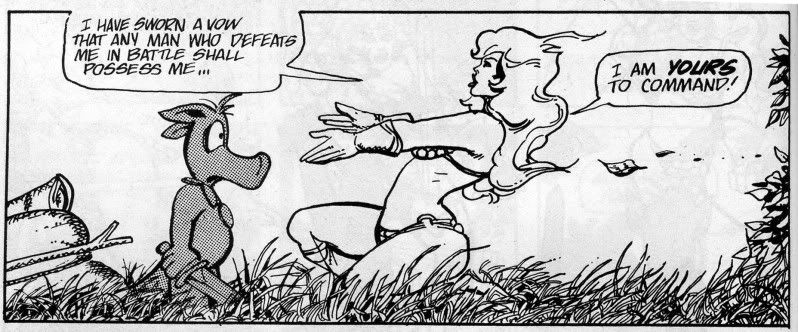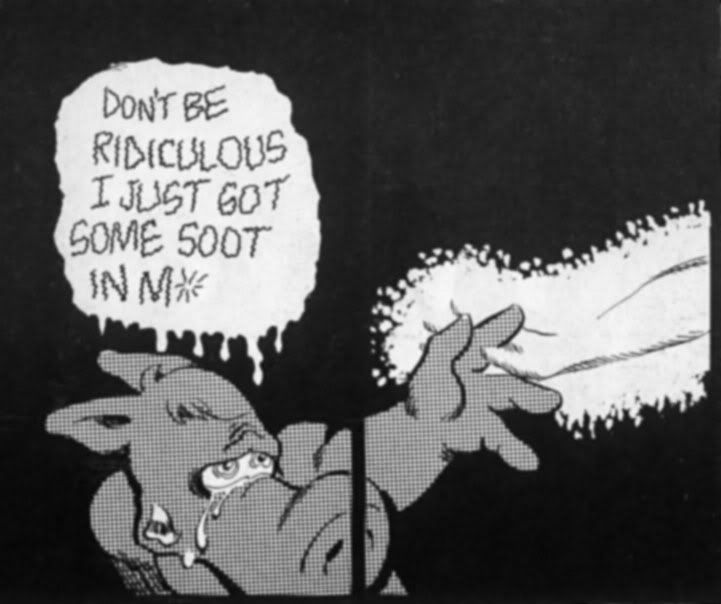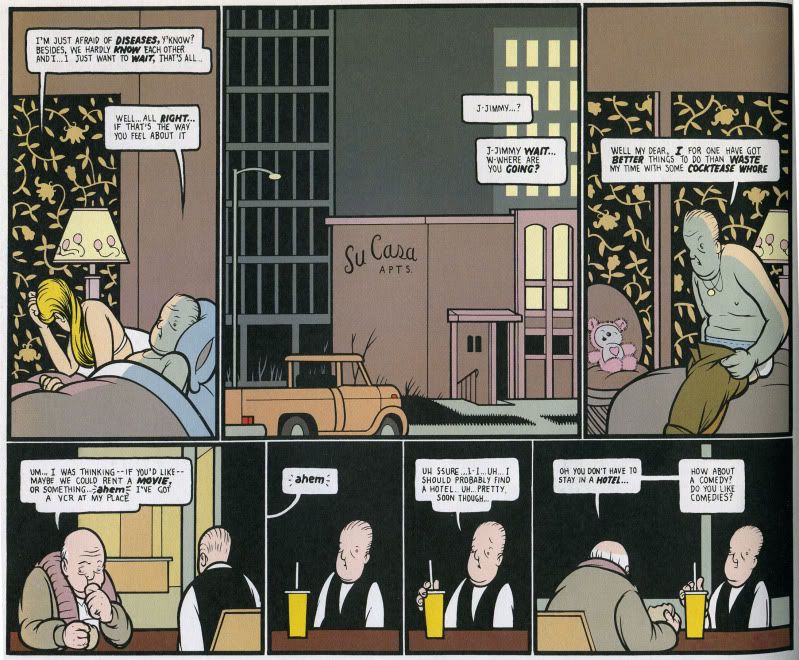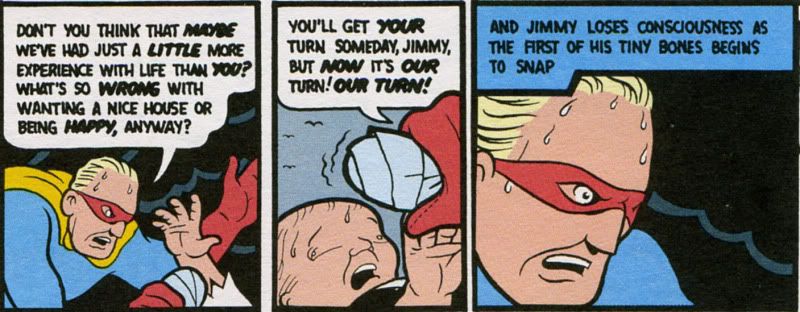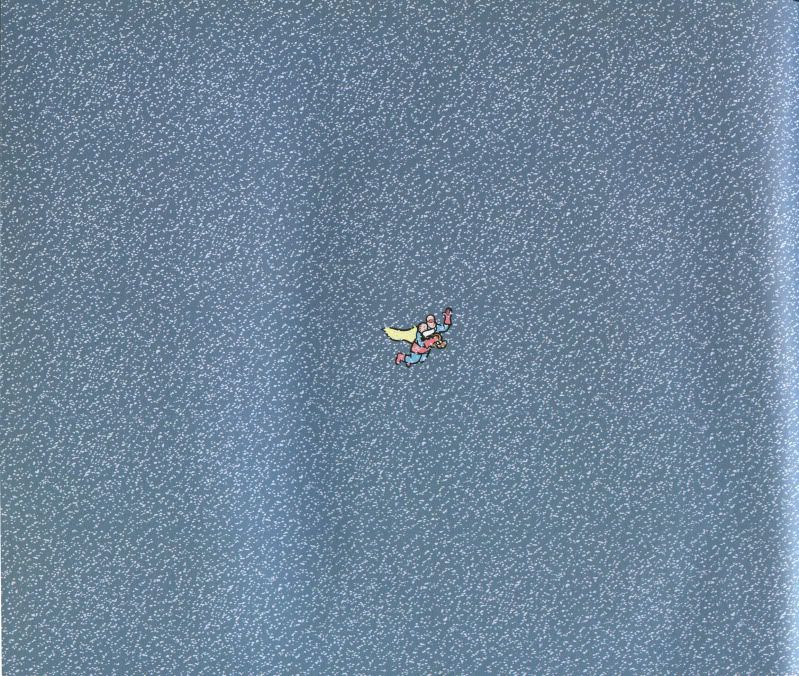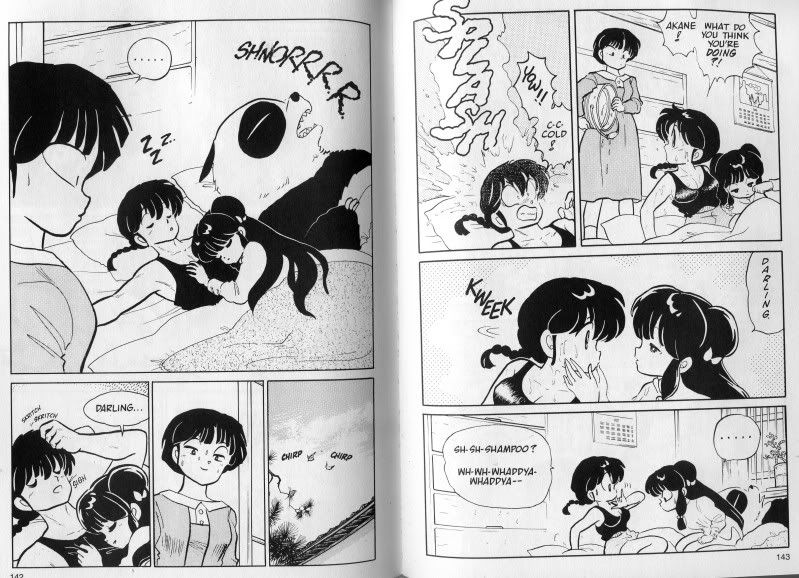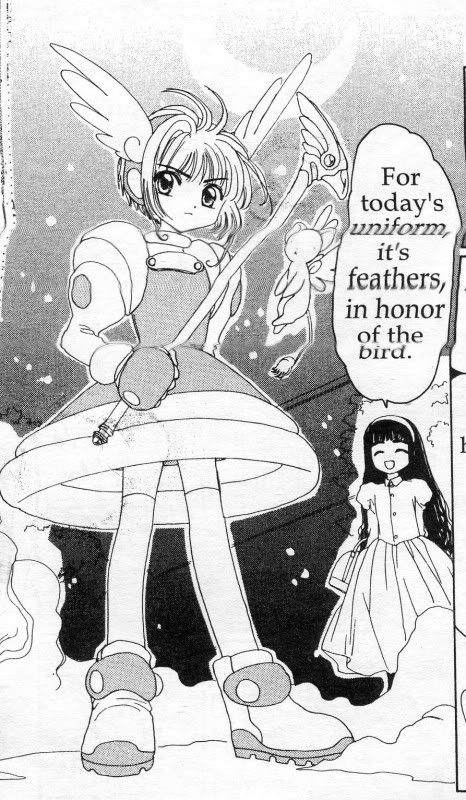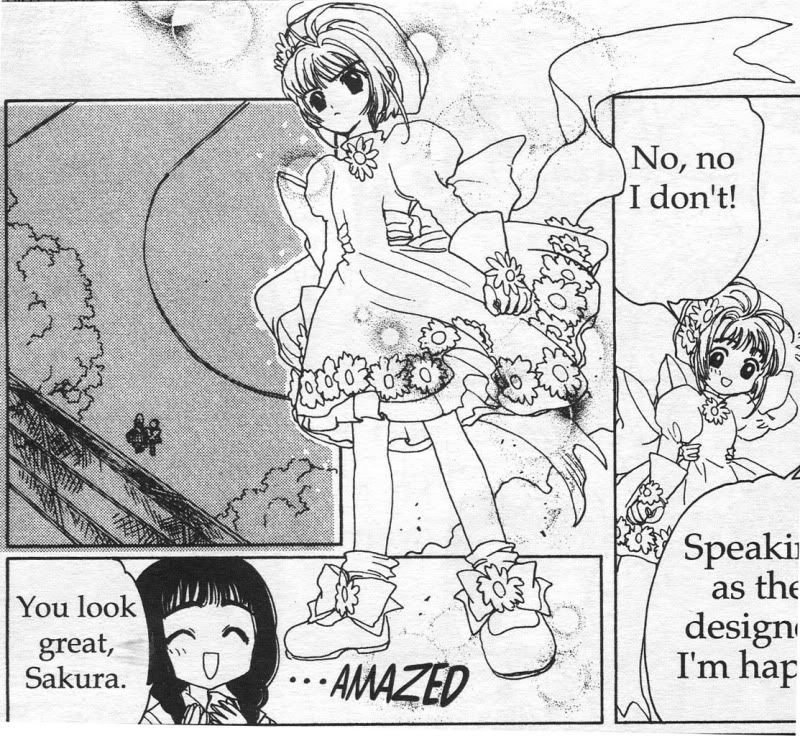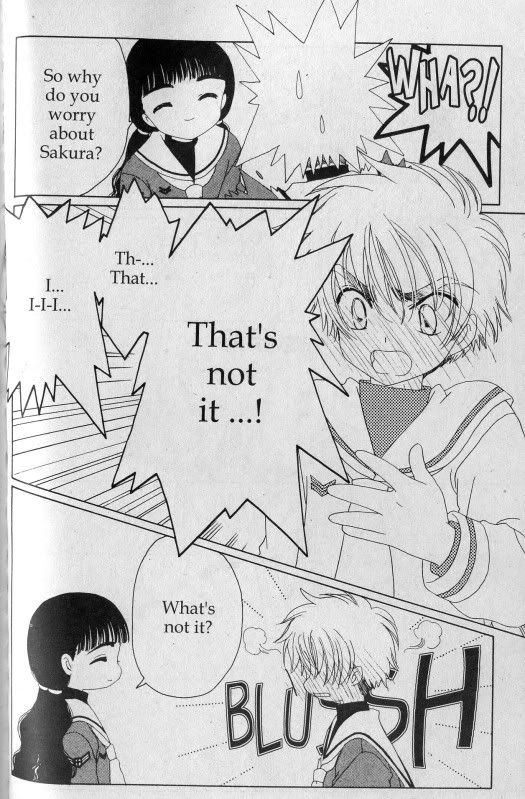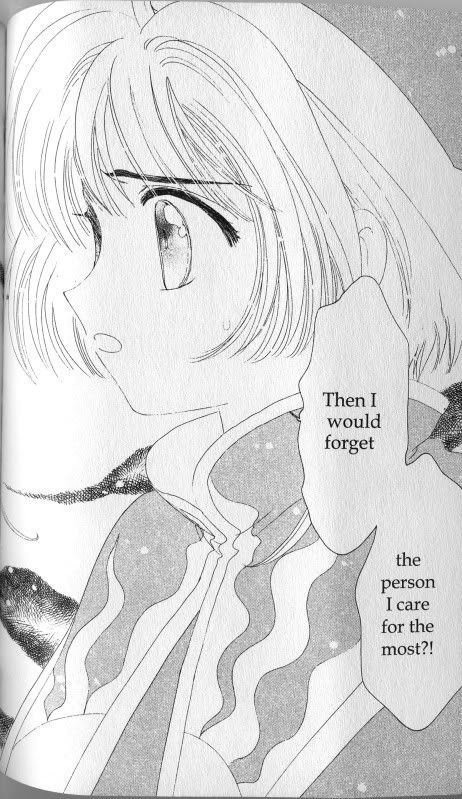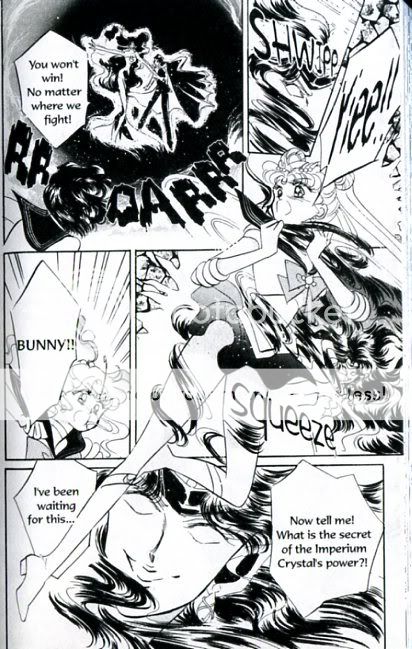This is the second part of a lecture I delivered last year. In the first part here I argue that super-hero comics are built around homsexual panic and repressed male bonding. In this second bit I’m extending that argument. (Be warned; there are some explicit images below.)
___________________
What’s really revealing, though, is the extent to which the nexus of sentiment/self-pity/troubled maleness transfers so seamlessly from these old, easily dismissed super-hero titles to much more intellectually and culturally validated efforts. For instance, there’s Cerebus, Dave Sim’s extremely successful self-published black-and-white 80s mega-series in about a gazillion volumes about a sword-fighting aardvark and the meaning of the universe, not necessarily in that order. Cerebus is one of the most influential and respected English-language comics of the last thirty years or so. And in it, Sim goes out of his way to make fun of the whole idea of manly adventure narratives in general, and, at various points, of super-heroes in particular. Yet, despite its ironic distancing, Cerebus is in fact engaged and even obsessed with the same kind of conflicted masculinity that we’ve been discussing.
From its beginning, Cerebus is a parody of a particularly overblown masculinity. In fact, the central, ongoing joke of the series is that Cerebus behaves like Conan and yet, he’s clearly not Conan. In other words, Cerebus is in part a funny character because he has all the attributes of hyper-masculinity (temper, violence, a certain kind of competence, emotional distance, etc.) even though he is essentially a (feminine-associated) plush toy. The joke is heightened by the fact that the other characters in the story are, for the most part, oblivious. Cerebus is treated as if he had all the privileges of masulinity — women try to seduce him, for example, and he is treated as a political threat. Or, to put it another way, Cerebus successfully passes as a traditional (heterosexual) man.
And here’s just two pictures of women throwing themselves at Cerebus — a Red Sonja like barbarian maid from the first volume:
And a high-powered sophisticated political operator from High Society, the second volume.
Part of the pleasure of the story, especially on the early outings, is the reader’s awareness of this open secret — a secret everyone in the book knows, and yet which is only rarely alluded to. Cerebus himself doesn’t talk about it, or even seem to notice it for the most part. And yet, even as the story becomes more intricate and the formative Conan meme fades into the background, the fact of Cerebus’ difference, and its relation to his masculinity, remains of central importance. The second volume of the series, High Society can, it seems to me, be read as a story about Cerebus’ masculinity — his efforts to eschew femininity, and lay hold of a manhood which he obviously doesn’t really possess. Ironically, most of these efforts to resist the feminine involve precisely turning down offers of sex and/or close relationships with women (as you can see, in the picture above, Cerebus is engaged in loud protestations of continence.) So is this (not always successful) imperviousness to female attention a sign of Cerebus’ true status as a manly-man? Or is it a sign that he is something other than a man, after all — another species perhaps? Or maybe it’s both?
In any case, the emotional climax of High Society is very near the end. Cerebus is saying his farewell to the super-feminine elf maiden, with whom he has a somewhat prickly friendship. And, as they’re parting, Cerebus breaks down and cries.
Of course, Cerebus is claiming to have something in his eye because he’s too manly to admit to giving in to sentiment. But that refusal is itself more sentimental — the tears are heightened in impact and importance because Cerebus is the sort of guy, or whatever, who is unwilling to cry. Emotional coldness and imperviousness is the romanticized soul of gloppy sentiment.
Dave Sim, the author and artist here, actually has a very strange history; sometime after he wrote these comics, he experienced a kind of religious awakening, which led him to conclude, among other things, that women aren’t human, that feminism is a great conspiracy against all that is good and right, and that homosexuality is despicable. He also became a rabid believer in his own pure rationality, and in the unbearably flawed otherness of all things emotional. Here’s a fairly typical quote from his later days:
Emotion, whatever the Female Void would have you believe, is not a more Exalted State than is Thought. In point of fact, I think Emotion is animalistic, serpent-brain stuff. Animals do not Think, but I am reasonably certain that they have Emotions. ‘Eating this makes me Happy.’ ‘When my fur is all wet and I am cold, it makes me Sad.” “Ooo! Puppies!’ ‘It makes me Excited to Chase the Ball!’ Reason, as any husband can tell you, doesn’t stand a chance in an argument with Emotion… this was the fundamental reason, I believe, that women were denied the vote for so long.
I like especially the way he randomly capitalizes various words, like “Female Void”‘ “Exalted State”, “Emotion” etc. And when he talks about the female void, it’s not nearly as metaphoric as you might think; he’s got pretty bizarre cosmological ideas.
Anyway, later volumes of Cerebus deal more explicitly with gayness — or so I’m told. I actually found the second volume a chore to wade through, in large part because of the hamfisted way gender is handled, and since I know it only gets worse from there, I haven’t been inspired to go on. But, obviously, there’s a continuity between the conflicted and romanticized comic-booky take on masculinity here, and his rejection of all things feminine later in his life.
Not that it’s just right-wing whackos who are attracted to masculine sentiment. Conflicted male-bonding is at the center of Art Spiegelman’s indisputably liberal Maus, for example, in which all the father-son angst actually manages to overshadow the Holocaust. And lots of male autobiographical comics by folks like Jeff Brown or David Heatley or Ivan Brunetti are basically about guys feeling sorry for themselves. (If you haven’t read any of those folks, well…don’t.) Dan Clowes does a lot of work in this vein as well; the title character of David Boring has unresolved fetishes and sexual issues more or less linked to his absent father, who, we learn, was an illustrator of super-hero comics.
And then there’s Chris Ware’s best known comic, Jimmy Corrigan. Corrigan is basically a realistic story; no gargantuan semi-clothed behemoths switching brains as a prelude to uber-violence; no diminutive semi-clothed aardvark barbarians turning down sexual advances as a prelude to swordplay. But nonetheless, it’s vision of maleness is oddly familiar.
First of all, like Batman and Superman and Spider-Man, Jimmy Corrigan loses his father early in his life (though in his case it’s through divorce rather than death). And, like his costumed predecessors, this lack of a father is figured as the defining emotional fact of his life. Surely it’s his wounding and his loss which makes the utterly repulsive (racist, emotionally inaccessible) Corrigan at all palatable, just as Bruce Wayne’s nocturnal nuttiness is made coherent by his tragedy.
Here’s one page form Ware’s Jimmy Corrigan.
The top part is a quick and unexplained flashback, showing Jimmy in a failed one-night stand. The woman has gotten cold feet, so Jimmy leaves her with the sensitive exit line, “Well, my dear, I for one have better things to do than waste my time with some cocktease whore.” The bottom sequence shows Jimmy awkwardly interacting with his father, whom he has just met. The parallel paths here are, I think, supposed to be emotionally linked, and maybe even causal. Jimmy’s failed relationship with his father on the bottom of the page is supposed to explain his overweening but incompetent heterosexuality. Or, to put it another way, beneath the icky heterosexual interaction is an icky male-male interaction of greater importance.
Ware, in other words, relies for his emotional effects on the exact same dynamic as Batman, Stan Lee, and all those old pulpy super-hero comics did. It’s all about men ostentatiously refusing to cry about their lack of manhood, mourning their failure to be heterosexual icons. Ware himself makes the connection quite explicit. A recurring character in Ware’s comics is a super-hero named Superman. This Superman isn’t quite like the one you’re familiar with. The costume’s different for one thing. For another, though he’s billed as a hero, he tends to behave more as a sadistic super-powered bully. In my favorite of Ware’s comics, Superman strands Jimmy Corrigan on an island for years, occasionally visiting him to break his arm, mock him, or masturbate to dirty films starring Jimmy’s mother.
Here’s a picture of Superman abusing a young Jimmy Corrigan.
In this sequence, Ware is, I think, critiquing the kind of conflicted masculinity we’re discussing. Superman is an ogre of empowered masculinity, but his violence, as always in these situations, seems linked to self-doubt and self-justification. He drops Jimmy on the island because Jimmy dislikes his new stepfather. Superman reacts to this seemingly minor threat to patriarchal and adult authority with hyperbolic violence. Control and arbitrary power are built on a masculinity absorbed in eternally mourning its own potential failure. The fear and pity of failing to be a man justifies anything.
Unfortunately, when he collected his Jimmy Corrigan strips into a complete work, Ware decided to leave this material out. Superman is still present as a character of sorts, but he’s not “real.” On the one hand, he’s just some guy dressed up in a super suit who sleeps with Jimmy’s mom. On the other hand, he’s a metaphor floating about at the edges of the narrative. The frightening authoritarian masculinity that Ware created in the early strips is carefully bifurcated, and what we end up with is a figure ripe for enabling sentiment. Instead of critiquing comic-book maleness and its compulsive dynamic of pity and violence, Ware embraces it. Superman becomes a symbol for the elegaic sadness of insufficiently heterosexual nerds everywhere.
For instance, here’s another page from Jimmy Corrigan; that’s Jimmy Corrigan and his father erupting from Jimmy’s stylized mouth in an explosion of agonized and bifurcated male self-birth. In the background you see Jimmy sitting on the toilet wearing a Superman shirt.
And this is the last image of the comic; Superman flying amidst the falling snow. It’s similar to the final melancholy transcendence in James Joyce’s “The Dead” — except here the nostalgic swoon is prompted not by mortality or doomed lovers, but by the iconic super-hero father-figure.
Ware’s move here in turning comics themselves, as a cultural artifact, into signifiers of beautifully failed maleness, is actually a more and more popular move for thoughtful intellectuals. To the limited extent that I was able to force myself to read it, it seemed to be what Michael Chabon was doing in *Kavalier and Clay* for example. That novel is about the friendship between two Jewish comic-book creators set in the early twentieth century, and, it mostly deals with nostalgic atmosphere and male-bonding, both tied explicitly to super-hero fantasies. Fiction writer Jonathan Lethem gets at something similar when he muses that:
“This is a closed circuit, me and the comics which I read and which read me, and the reading of which by one another, me and the comics, I am now attempting to read, or reread. The fact is I’m dealing with a realm of masturbation, of personal arcana. Stan Lee’s rhetoric of community was a weird vibrant lie: every single true believer, every single member of the Make Mine Marvel society or whatever the fuck we were meant to be called, received the comics as a private communion with our own obscure and shameful yearnings, and it was miraculous and pornographic to so much as breathe of it to another boy, let alone be initiated by one more knowing.”
An all-male community tied together by “obscure and shameful yearnings,” in which it is “pornographic” to be “inititated by one more knowing” — could there be a clearer description of the closet? Comics are every man’s shameful truth; the sign that he is not really or fully a man. But, and in the same way, they serve as his apotheosis; he is special, because he understands comics. His otherness is his tragedy and his sentimental validation. The secret identity is simply lover of comics — the love that, on the one hand, dare not speak its name, and, on the other, won’t cease sentimentally snivelling about it.
In her book, Eve Sedgwick talks a lot about the dangers of labeling something “sentimental.” As she points out, the tendency is to use “sentimental” as a feminizing insult. I’ve perhaps been guilty of that here. But my problem with the sentimentality of American comics isn’t so much the sentiment itself as the kind of sentiment expressed and where it seems to point. So as a point of comparison, I want to turn briefly to another comics tradition.
Japanese comics, or manga, have developed very differently from comics in America. Most importantly for our purposes, manga isn’t predominantly male, the way American comics is. On the contrary, there’s a whole genre of manga, called shojo, directed at, and mostly created by, women. I’ve been arguing that American comics are furtively and anxiously gay; shojo, on the other hand, is openly, enthusiastically flamboyant. In shojo books, men turn into women, women turn into men, and characters fall in love with a delirious unconcern for boundaries of age, station, or gender.
For example, here’s a scene from Rumiko Takahashi’s, Ranma 1/2, where Ranma turns into a girl. Note that Ranma isn’t technically a shojo title — it was first serialized in a shonen magazine for boys. However, it was hugely popular, so both boys and girls read it, and it’s fairly clearly in a shojo tradition in a number of ways, even if it isn’t “really shojo.” (Just wanted to make that clear in case there are manga addicts out there waiting to trip me up.)
And below is a very explicit panel from Fumi Yoshinaga’s “Gerard and Jacques” depicting a homosexual, intergenerational quasi-rape.
This is actually an example of a subgenre of shojo called yaoi. Yaoi like all shojo, is mostly by and for women, but it features homosexual relationships between men. Often these relationships, as here, are very explicit. Yaoi is very popular in Japan, and is catching on here as well. Since it’s not a genre native to the U.S., lots of people sort of look at it strangely and say, basically “What? Women want to read stories about gay men having sex? What’s with that?” I have some answers to that, but here I just want to point out that the gender politics in American comics are *at least* as bizarre and homoerotic as those in Japanese ones.
So shojo has a lot of gender bending, and a lot of openly gay content. This isn’t to say that shojo repudiates the closet. On the contrary, sexual secrets are extremely important in the genre, and those secrets are productive, as they tend to be, of tons of melodrama and even more gushy sentiment. As an example, take the series Cardcaptor Sakura, written by a female collective which goes by the name of CLAMP. The series is about an elementary-school-girl named Sakura who must collect a series of magical cards while wearing a succession of excessively girly outfits.
And here’s a couple of those outfits from just the first volume:
The improbable plot, and even the improbable fashion statements, are both much less important than character interactions — basically, everyone has a crush on everyone else, and the narrative momentum happily effervesces into a haze of unrequited sighs, longing looks, pregnant silences, and moments of ecstatic embarrassment.
So, for example, here’s one character blushing as his secret crush is revealed.
Despite all this extended teasing, the title does manage to reach a climactic moment, when, having collected all the cards, Sakura is confronted with a final magical trial. In a super-hero comic, this would be the moment in which the villain threatens to blow up the city, or the world, or the multiverse. CLAMP, though, refuses to go there — they explicitly state that if Sakura fails, “The Evil that is released…isn’t something…that will destroy the world or move Heaven and Earth.” Instead, if the evil triumphs, all of the main characters will simply forget the person “they care for most.” Everybody’s secret crush will be erased.
Here’s Sakura learning that she will forget the person she cares for the most.
My first reaction on reading this was, “oh, come on.” I mean, how preposterous, not to mention sappy, can you get? But the more I thought about it, the more it seemed exactly right. In Cardcaptor Sakura, and in shojo in general, the stories are held together by relationships. Many of those relationships are unrequited or unspoken…but that doesn’t make them less important. The love you don’t say can be the point of your life; secret love is meaning. Without it, Cardcaptor Sakura’s narrative, its world, would come apart. In Cardcaptor Sakura, the closet exists, but it opens outward. And what you find inside is love, which invisibly binds together the world in a web of affection and sentiment.
In contrast, the American comics I’ve been discussing look suspiciously like the emotionally empty world which Sakura struggles to avert. What happens when your crush disappears? Does sentiment vanish? Or does there remain the sense of a secret without content; an empty closet in which emotion rots and festers, slowly poisoning itself? Batman and Cerebus and Jimmy Corrigan all hide the fact that they have nothing to hide. The inside of their closets contain, not love, but love’s absence — an incoherent dream of an identity that never was. And if love produces life, this vapor creates only a simulacrum — an empty image of an empty self.
That simulacrum of a dream is masculinity — the non-face you get if you fold and spindle your entire comics collection like one of those old Mad magazine Al Jaffee fold-ins. In America, comic books are men, men are comic books, and the two drop, one from the other in an endless series of immaculately tedious births. Manliness isn’t so much a secret identity as it is a repetitive compulsion. That’s why, whether radioactive high school student, anthropomorphic animal, or literary darling, American comics characters always seem to be putting on the same damn mask.
_______________
Update: Another post with some similar related thoughts here.

